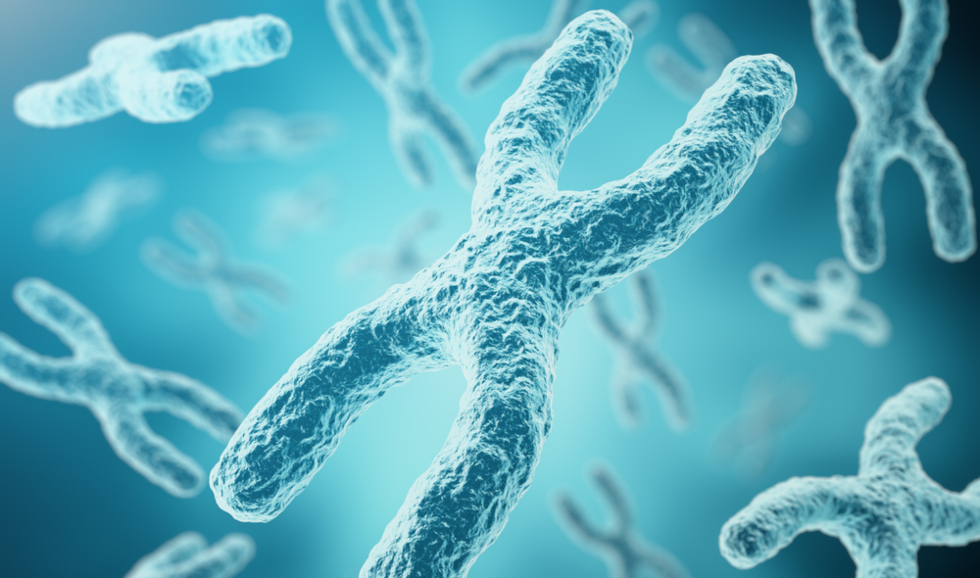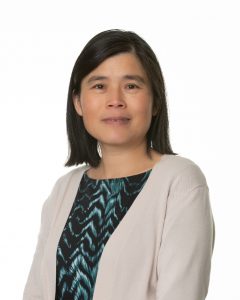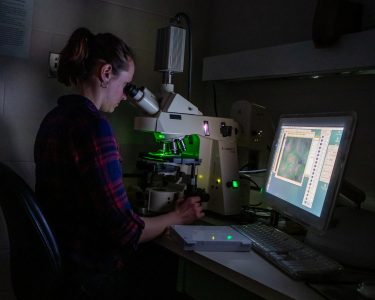Repair work: A Q and A with researcher Xu-Dong Zhu

Image by Rost9/Shutterstock
BY Sara Laux
September 15, 2020
Xu-Dong Zhu is an associate professor in the department of biology whose work focuses on understanding how cells repair DNA damage — and what happens when they can’t.
Tell me about your research
 Broadly speaking, my research is associated with cancer and aging. By looking at human cells at the molecular level, we’re trying to understand how a normal human cell could turn into a cancerous cell.
Broadly speaking, my research is associated with cancer and aging. By looking at human cells at the molecular level, we’re trying to understand how a normal human cell could turn into a cancerous cell.
More specifically, we’re looking at molecular pathways that deal with repair of DNA damage.
We know that the accumulation of DNA damage, if not repaired properly, is one of the driving forces for aging and the development of cancer, so we’re trying to understand the molecular pathways for how cells repair or eliminate DNA damage.
This work could potentially lead to the discovery of new targets for cancer treatment, or biomarkers for cancer diagnosis.
How do cells repair DNA damage? Why does that repair process break down?
As we age, the levels of proteins in our cells that are responsible for repairing DNA damage are reduced. That’s one of the reasons that cancer is most commonly found in older people.
We primarily study DNA double-strand break repair. DNA double-strand breaks, in which both strands of the DNA helix are broken, are one of the most lethal forms of DNA damage, and can be induced by agents such as ionizing radiation, x-rays and various chemotherapeutic drugs.
Paradoxically, while the failure to repair double-strand breaks properly can lead to cancer, many chemotherapeutic drugs are designed to kill cancers by introducing massive DNA damage, including double-strand breaks – so we’re trying to understand how cancer cells repair these breaks.
How did you get into this research?
When I was a senior graduate student at the University of Toronto, I attended a seminar by Carol Greider who worked with her mentor, Elizabeth Blackburn, to discover telomerase.
Both of them eventually got the Nobel Prize for the discovery.
Telomerase can help extend telomeres, which are the ends of chromosomes. This is significant, because as we get older, our telomere length gets shorter and shorter. With the discovery of telomerase, there was the thought that you could rejuvenate your telomere length and stop the aging process.

When I went to this talk, I was thinking about what field of research I’d like to pursue as a postdoc, and I was fascinated by the idea of a potential way to overcome aging.
I was fortunate to do a postdoctoral appointment in Titia de Lange’s lab at Rockefeller University. She established the field of telomere research in humans, and discovered many of the proteins that are bound to telomere DNA and regulate telomere length in human cells. As a postdoctoral fellow in her lab, I discovered that human telomeres are associated with DNA repair proteins.
When I first came to Mac, the first 10 years of my work focused on the functional crosstalk among telomere binding proteins and proteins involved in DNA repair. In recent years, my research focus has shifted to understanding the molecular pathways governing DNA repair and the maintenance of genomic integrity.
What first interested you in science and biology?
I have always been a curious person – I like to know how things work. My favourite subject in high school and university was organic and physical chemistry. A lot of that logical thinking and curiosity applies to all types of science disciplines, so when I transitioned into molecular biology, that training and nature helped and was still applicable.
Are there challenges with doing the type of research you do?
Discovery comes with a lot of hard work, with the hope that one day we’ll be able to have a significant impact on human society, but many discoveries are also incremental – we can have a big goal and a lot of hope, but results may happen in a much longer timeframe.
One must recognize that basic research isn’t something that’s going to realize a profit in three years.
Have there been any big surprises in your work?
We’ve definitely encountered unexpected outcomes. For example, we are studying the Cockayne syndrome group B protein, which is very well known to be involved in the repair of UV damage.
My lab was actually the first to report that this protein regulates the double-strand break repair pathway choice and helps prevent genome instability, an underlying hallmark of cancer and aging. Our work suggests that this protein could serve as a target for cancer treatment and be a biomarker for cancer diagnosis.
As a researcher, what keeps you going?
Curiosity! I really want to know what’s going to happen next. I like solving puzzles – and I want to know what new things we’ll find out.


